| Stardust
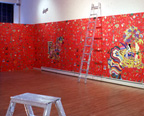  Installation
views of Stardust. Installation
views of Stardust.
Let's celebrate memories and dreams by embracing
the mundane and pop elements of our lives. Stardust is
a mix of Yellow Submarine with Saturday Night Fever. Assume
Vivid Astro Focus and Kalaman are not afraid
to defend the beauty of commodities. They produce, explore,
exploit, sell and expose their works in many manners. They
are pro-product and optimistically accept personal attachment
to corporate culture. The Beatles, Adidas, soccer, cartoons
and Atari can still inflict a starry-eyed unconditional
innocence. Both artists employ pseudonyms, but for different
reasons: Robert Lutz uses Kalaman as a brand name for his
art; Eli Sudbrack founded Assume Vivid Astro Focus as a
communal life style. Both strategies stem from advertising
and the belief that their attitude should be shared.
Kalaman leverages the brand equity of Germany
by appropriating Adidas iconography, as well as more banal
standardized industrial products including pencils, t-shirts
and ladders. Through irony, he creates work revealing the
pride and sentiment of German products and their relationship
to their precise production and highly considered craftsmanship: "Made
in Germany" or in this case: "Made by Kalaman".
Without apology "he" is a company, an idea factory.
Another point of entry is in his critique
of criticism. Playing on politically correct language he
has employed children to produce pieces (Guaranteed Child
Labor) and created works such as a mousetrap with the word "unfair".
Other work takes a less sarcastic view. The ladder series
(First Step, Stairway to Heaven and I am so high) relates
to the innocent aspiration of becoming famous. Industrial
ladders are covered with mirrored tiles, capitalizing on
our obvious desire for stardom. Reflective tiles also cover
three-dimensional bubble script sculptures. Decontextualized
glittering words like happiness and dope float into ones
mind like disco balls hypnotizing the dance floor.
Assume Vivid Astro Focus is a dynamic project,
which operates as a collective force. Audience members
can take part in the project on the premises or at home
via postcards, stickers, etc. At its core, it is art as
fan club. AVAF has developed a universe and philosophy
flowered with psychedelic protagonists influenced by memories
of childhood and wonder. It is a world of fantasy and dreams,
where happiness replaces despair and skeptical irony.
Even though AVAF embraces similar ideas as
Kalaman regarding consumerism and pop culture, the approach
is more ethereal and dreamy. Manipulating "commercial
art" references such as Peter Max and Milton Glaser,
AVAF creates a disclosed world of personal introspection.
Rediscovery and uncritical innocence conjure up a romantic
déjà-vu. Using 60's inspired mural installations
where fluorescent imagery and cartoony decals float on
graphic backgrounds, whirls of memories emerge from this
kaleidoscope of illustrations.
Stardust is a state of being; it draws
on our fading memory and allows it to be present. Through
the process of mining memories held by the public, they
become personal and meaningful. Without preconception,
both artists celebrate the popular culture of "glam-rock",
slang and an accumulation of seemingly shallow experience.
It is about letting go, having fun, celebration and bliss.
Fernanda Arruda, Director, Anton Kern Gallery
Artists:
Kalaman (b. Germany, 1966; lives in Cologne)
Assume Vivid Astro Focus aka Eli Sudbrack (b.
Brazil, 1968; lives in New York)
Second Glance
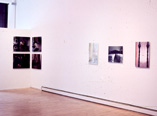
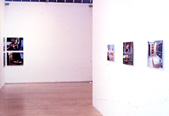 Installation
views of Second Glance. Installation
views of Second Glance.
Imagery is often not what it seems at first
glance. The eye and the mind work together to make assumptions
in hopes of providing a logical, basic understanding of
what is presented. However, this is only the first step.
Imagery cannot be taken at face value. We are inundated
by visual stimuli to a point beyond recognition or absorption,
and the images themselves can no longer be seen as a representation
of truth. Photography automatically explores this occurrence,
as its processes involve various forms of manipulation.
The photographs of Laura Carton and Jonathan
Grassi play with initial perceptions. They share
a necessity for reexamination. Both artists present seemingly
normal, perhaps even clichéd scenes: Carton's
range of interiors devoid of figures; Grassi's interactions
of people in bare spaces. However, each artist creates
a dynamic opposition between the cursory and informed
viewings of their work.
The importance of Laura Carton's works lies
not in what is present, but what is missing. She has taken
Internet pornography and digitally erased the figures.
Images that appear to be travel snapshots or postcards
take on a secondary layer of meaning. They exist at the
brink of action and allude to the fact that something erotic
and/or illicit has happened in this location. The viewer
can't help but imagine it. A calm, almost overlooked dining
room or bedroom scene instantly becomes a staged scenario.
The absence of figures invites the viewer to place himself
in these settings, an indulgence that seems simultaneously
intriguing and disarming.
Jonathan Grassi photographs fabricated realities.
The scenes are unsettlingly familiar, yet foreign in their
alienating subject matter. He portrays adolescents on the
brink of adulthood and places them into "plots" that
are left for the viewer to resolve. What results is a series
of ambiguous and suspenseful moments. A dramatic use of
color and light, and the inclusion of often disturbing
and violent details heighten the intensity of his images.
His construct of image versus idea tensely but poetically
estranges his characters as well as his audience. There
is a psychological distance between the viewers and the
subjects. As the perspective becomes more intimate the
characters become more anonymous. Grassi's visual language
is derived from popular culture, which serves as society's
contemporary mythology.
Laura Carton and Jonathan Grassi's photographs
appear as documents, but both mask fiction under the presumption
of truth. The complex rituals of visual appreciation are
used against us, as we must somehow involve ourselves in
and displace ourselves from this work. They are, in effect,
crime scenes: the viewer is an incriminated voyeur and
an inevitable detective.
Adam Frank, Assistant Director, Sara Meltzer Gallery
Artists:
Laura Carton attended the International
Center of Photography and is currently participating in
the Whitney Independent Study Program. She has been included
in exhibitions at the Aldrich Museum and Artists Space,
among others.
Jonathan Grassi received his B.A. from Parsons this year,
and was included in MoMA's Life of the City exhibition. Both artists
are based in New York.
Press Release:
 Kalaman Ladder, 2002 Kalaman Ladder, 2002
 Eli Sudbrack Wallpaper, 2002 Eli Sudbrack Wallpaper, 2002
Stardust
Stardust attempts
to examine art as a helpful healing device. In order to
achieve an exact and tangible effect of remedy and encouragement,
both Eli Sudbrack and Kalaman suggest art as a positive
therapeutic alternative. Robert Lutz uses the artist name
Kalaman as a branding plan for his work. His production
includes various kinds of multiples, like t-shirts, pencil,
rulers, jackets, etc. Ironically, Kalaman deals with the
idea of art as a product. Eli Sudbrack, aka Assume Vivid
Astro Focus, has developed a universe and philosophy flowered
with psychedelic protagonists influenced by childhood and
memories. As Sudbrack, the artist operates collectively,
allowing audience members to take part in the projects
on the premisis or at home via postcards and stickers.
With a trace of beauty these projects are a satisfying
experience. A criticism of highly intricate political events,
they demonstrate that art still works as a mechanism for
fun, humor and self-enlightenment.
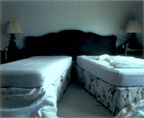 Laura Carton Untitled #7, 2002 Laura Carton Untitled #7, 2002
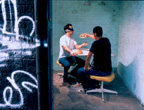 Jonathan Grassi Untitled from the Immunology Series, 2002 Jonathan Grassi Untitled from the Immunology Series, 2002
Second Glance
Second Imagery
is often not what it seems at first glance. The eye and
the mind work together to make assumptions and groupings
so as to provide a logical, basic understanding. However,
this is only the first step. Imagery cannot be taken at
face value. We are inundated by visual stimuli to a point
beyond recognition or absorption, and the images themselves
can no longer be seen as a representation of truth. Photography
automatically explores this occurrence, as its processes
involve various forms of manipulation. The photographs
of both Laura Carton and Jonathan Grassi play with initial
perceptions. They share a necessity for reexamination.The
importance of Laura Carton's works lies not in what is
present, but what is missing. She has taken Internet pornography
and digitally erased the figures. Thus, these images that
appear to be travel snapshots or postcards take on a secondary
layer of meaning. They exist at the brink of action, with
the knowledge that something erotic and/or illicit has
happened in this location. Grassi photographs staged scenarios
that are unsettlingly familiar, yet foreign in their alienating
subject matter. His work focuses on the psychology of distance,
between the viewer and the work, the figures in the work,
and the mental space created in his scenes. A cinematic
use of color and light, and the inclusion of often disgusting
and violent details heighten the intensity of his images. |

